Snow and Climate Bring Good and Bad Ski Conditions
Special Stories
20 Nov 2018 8:47 AM
[NOAA by Michon Scott] Based at the University of Colorado-Boulder, the National Snow and Ice Data Center (NSIDC) has no shortage of skiers experienced enough to know good—and bad—ski conditions. “Warm days plus cold nights can really make conditions painful,” opines software developer Matt Fisher. “You get the snow warming up during the day then icing over at night. It’s harder to keep control in icy conditions and when you fall, it really hurts.” Heidi McCann, coordinator of indigenous knowledge exchange agrees, adding that the most desirable snow has low water content, and ideally, eight or more inches of fresh powder.
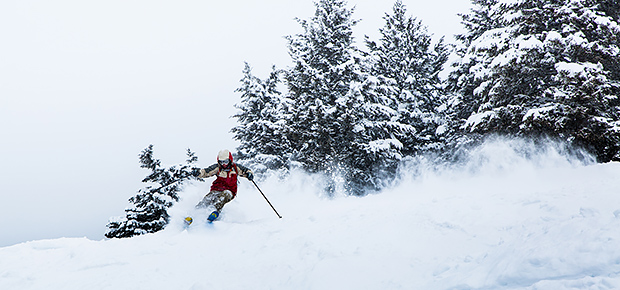 [A skier enjoys powder at Jackson Hole, Wyoming. CC license by Flickr user Zach Dischner.]
NSIDC research scientist Twila Moon works remotely from Big Sky, Montana, and calls herself “reasonably obsessed with skiing.” She lays out the optimal skiing conditions, which start before ski resorts open each season. “You can almost think of it as a timeline,” she explains. “Late fall into early winter is when you start to build up snowpack, when the snow layers bond together.”
Hazards to skiers during this period include hoarfrost, that can form under calm, humid, clear conditions; and ice lenses caused by surface melt or rain-on-snow events. Any snow accumulating on top of these flaky or icy layers is prone to avalanche. Depth hoar, which often forms in a shallow snowpack, can result in especially widespread instability throughout much of the remaining the season, potentially leading to catastrophic avalanches. While ski resorts try to mitigate avalanche risks, backcountry (cross-country) skiers must watch out for themselves.
[A skier enjoys powder at Jackson Hole, Wyoming. CC license by Flickr user Zach Dischner.]
NSIDC research scientist Twila Moon works remotely from Big Sky, Montana, and calls herself “reasonably obsessed with skiing.” She lays out the optimal skiing conditions, which start before ski resorts open each season. “You can almost think of it as a timeline,” she explains. “Late fall into early winter is when you start to build up snowpack, when the snow layers bond together.”
Hazards to skiers during this period include hoarfrost, that can form under calm, humid, clear conditions; and ice lenses caused by surface melt or rain-on-snow events. Any snow accumulating on top of these flaky or icy layers is prone to avalanche. Depth hoar, which often forms in a shallow snowpack, can result in especially widespread instability throughout much of the remaining the season, potentially leading to catastrophic avalanches. While ski resorts try to mitigate avalanche risks, backcountry (cross-country) skiers must watch out for themselves.
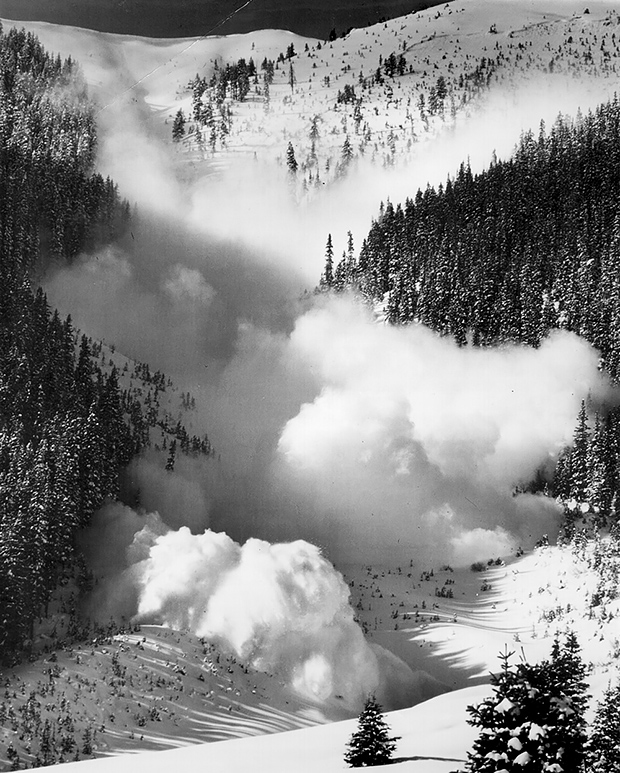 [Slope, terrain, and snowpack conditions can all contribute to avalanches. Photo by Richard Armstrong, NSIDC, via NOAA]
Once ski season is well underway, Moon says, the best conditions are not too cold for skiers to endure or for snow to continue falling, “but cold enough to build up powder. Having dry spells, or warm weather, or rain on snow are very problematic.” She adds, “Of course there’s the year-to-year luck of the weather, but it’s now happening against a background trend of warming temperatures.”
[Slope, terrain, and snowpack conditions can all contribute to avalanches. Photo by Richard Armstrong, NSIDC, via NOAA]
Once ski season is well underway, Moon says, the best conditions are not too cold for skiers to endure or for snow to continue falling, “but cold enough to build up powder. Having dry spells, or warm weather, or rain on snow are very problematic.” She adds, “Of course there’s the year-to-year luck of the weather, but it’s now happening against a background trend of warming temperatures.”
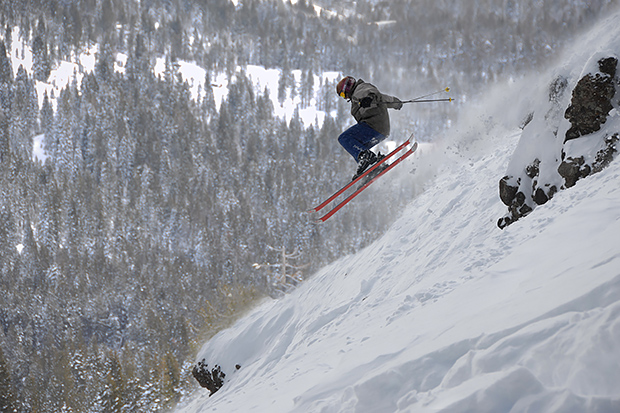 [A confident skier speeds down a steep slope at Lake Tahoe. CC license by Aaron Feen.]
Champagne and cement have long provided skiers with contrasting conditions, but regardless of the snow types that historically divided U.S. resorts, many of those resorts are now united by a shared problem: shrinking ski season. “Ski season is starting later and ending earlier,” McEvoy says—an observation shared by every researcher interviewed for this story. “We still get plenty of storms, but around here, I used to ski on Thanksgiving, when ski resorts really got going. Now, I’m lucky if I can ski that early.”
In the 2017-2018 ski season, the problem extended months after the holiday season. Around April 1, McEvoy said, snowpack in the region was about 75 percent of normal. “It doesn’t sound that bad, but almost all the snow came in March.” In February 2018, the Yosemite Ski and Snowboard Area offered its season pass holders the option of rolling over their passes to the following winter, or taking refunds. Meanwhile, the higher-elevation Mt. Rose Ski Area adopted a new slogan: Where the snow is!
Ski season is shortening at both ends. As worrisome as earlier spring melt may be for resorts serving Spring Break skiers, the worst economic losses likely strike during the holiday season. “The Christmas-New-Year’s week is the biggest week of ski season,” McEvoy says, “A lot of workers rely almost solely on the holiday period to make most of their money, and it’s not just people directly involved in the ski industry. Restaurants, bars, and other businesses rely on that busy season, too.”
[A confident skier speeds down a steep slope at Lake Tahoe. CC license by Aaron Feen.]
Champagne and cement have long provided skiers with contrasting conditions, but regardless of the snow types that historically divided U.S. resorts, many of those resorts are now united by a shared problem: shrinking ski season. “Ski season is starting later and ending earlier,” McEvoy says—an observation shared by every researcher interviewed for this story. “We still get plenty of storms, but around here, I used to ski on Thanksgiving, when ski resorts really got going. Now, I’m lucky if I can ski that early.”
In the 2017-2018 ski season, the problem extended months after the holiday season. Around April 1, McEvoy said, snowpack in the region was about 75 percent of normal. “It doesn’t sound that bad, but almost all the snow came in March.” In February 2018, the Yosemite Ski and Snowboard Area offered its season pass holders the option of rolling over their passes to the following winter, or taking refunds. Meanwhile, the higher-elevation Mt. Rose Ski Area adopted a new slogan: Where the snow is!
Ski season is shortening at both ends. As worrisome as earlier spring melt may be for resorts serving Spring Break skiers, the worst economic losses likely strike during the holiday season. “The Christmas-New-Year’s week is the biggest week of ski season,” McEvoy says, “A lot of workers rely almost solely on the holiday period to make most of their money, and it’s not just people directly involved in the ski industry. Restaurants, bars, and other businesses rely on that busy season, too.”
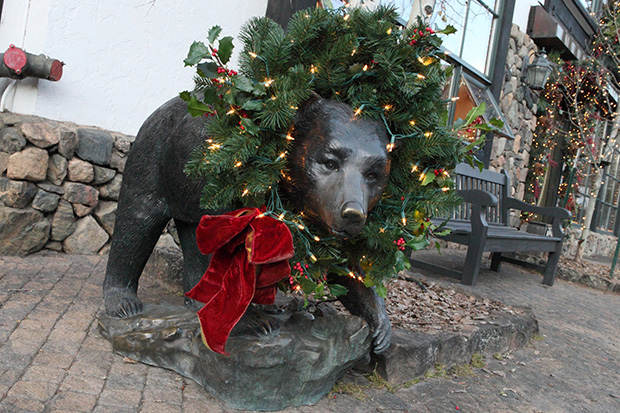 [A holiday wreath adorns a bear statue in Vail, Colorado. CC license by Flickr user Sam Howzit.]
[A holiday wreath adorns a bear statue in Vail, Colorado. CC license by Flickr user Sam Howzit.]
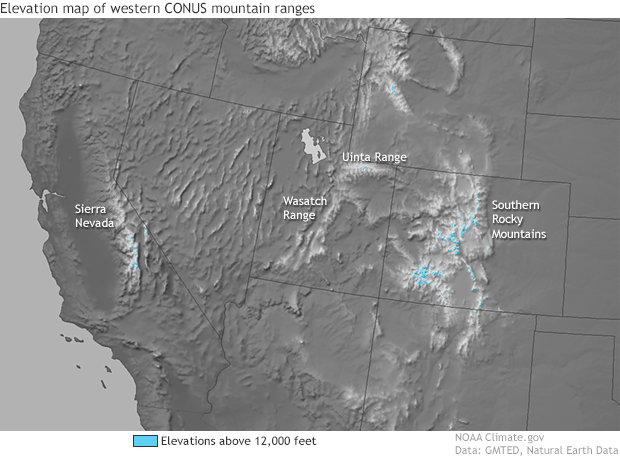 [Map showing areas of elevation above 12,000 feet in blue. From NOAA Climate.]
McEvoy and one of his colleagues at the Western Regional Climate Center, researcher Benjamin Hatchett, coauthored a 2017 study examining Sierra Nevada precipitation from 1951 to 2017, identifying multiple causes for regional “snow droughts.” Among those causes, they identified rain-on-snow events. From 2008 to 2017, the fraction of precipitation falling as snow declined at a rate of 3.5 percent per year. Hatchett also led another study on rising snow lines in the Northern Sierra Nevada.
Climbing snow lines have already become an issue at some ski resorts, presenting problems the original designers probably never anticipated. Ski-obsessed Moon gives an example from western Canada. “At the ski resort in Whistler, British Columbia, there’s a big elevation difference. You can have times when there is snow at the summit and rain at the base, where you get on the ski lift.”
Riding the gondola to the summit while soaking wet from rain might be unpleasant. Skiing right off the edge of the snow on your way back down might be even worse.
[Map showing areas of elevation above 12,000 feet in blue. From NOAA Climate.]
McEvoy and one of his colleagues at the Western Regional Climate Center, researcher Benjamin Hatchett, coauthored a 2017 study examining Sierra Nevada precipitation from 1951 to 2017, identifying multiple causes for regional “snow droughts.” Among those causes, they identified rain-on-snow events. From 2008 to 2017, the fraction of precipitation falling as snow declined at a rate of 3.5 percent per year. Hatchett also led another study on rising snow lines in the Northern Sierra Nevada.
Climbing snow lines have already become an issue at some ski resorts, presenting problems the original designers probably never anticipated. Ski-obsessed Moon gives an example from western Canada. “At the ski resort in Whistler, British Columbia, there’s a big elevation difference. You can have times when there is snow at the summit and rain at the base, where you get on the ski lift.”
Riding the gondola to the summit while soaking wet from rain might be unpleasant. Skiing right off the edge of the snow on your way back down might be even worse.
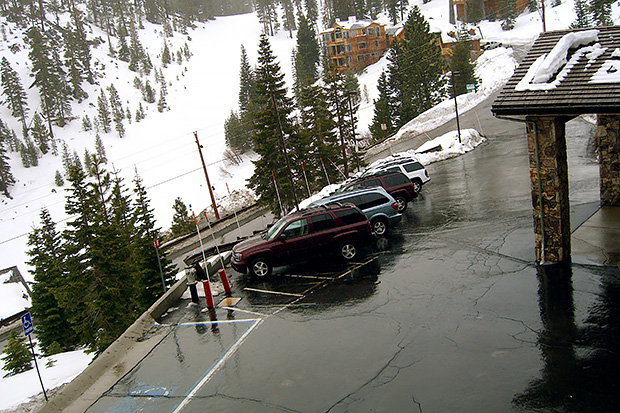 [Rain ruins skiiing fun at Lake Tahoe. CC license by Flickr user Armistead Booker.]
[Rain ruins skiiing fun at Lake Tahoe. CC license by Flickr user Armistead Booker.]
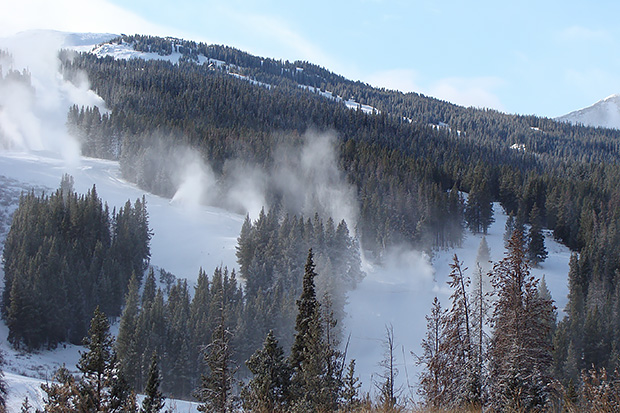 [Snowmaking has become routine at many ski resorts. CC license by Flickr user Jimmy Thomas.]
Like natural snow, artificial is only possible under certain conditions, and both temperature and humidity play a part. Under average humidity (60 percent), artificial snow can be produced at about 27°F, and better snow can be produced at 21°F. Wobus expresses admiration for how the process has been automated. "I talked to a snowmaker at Aspen,” he says. “The old systems involved people on snowmobiles moving equipment around. Now, when the temperature is cold enough, he gets an automatic alert. He can turn on the snowmaking system from his iPhone. Because the windows of opportunity to make snow will get smaller, resorts will have to take advantage of better processes, not just because of the carbon footprint, but also because of the cost.”
Edited for WeatherNation by Meteorologist Mace Michaels
[Snowmaking has become routine at many ski resorts. CC license by Flickr user Jimmy Thomas.]
Like natural snow, artificial is only possible under certain conditions, and both temperature and humidity play a part. Under average humidity (60 percent), artificial snow can be produced at about 27°F, and better snow can be produced at 21°F. Wobus expresses admiration for how the process has been automated. "I talked to a snowmaker at Aspen,” he says. “The old systems involved people on snowmobiles moving equipment around. Now, when the temperature is cold enough, he gets an automatic alert. He can turn on the snowmaking system from his iPhone. Because the windows of opportunity to make snow will get smaller, resorts will have to take advantage of better processes, not just because of the carbon footprint, but also because of the cost.”
Edited for WeatherNation by Meteorologist Mace Michaels
 [A skier enjoys powder at Jackson Hole, Wyoming. CC license by Flickr user Zach Dischner.]
NSIDC research scientist Twila Moon works remotely from Big Sky, Montana, and calls herself “reasonably obsessed with skiing.” She lays out the optimal skiing conditions, which start before ski resorts open each season. “You can almost think of it as a timeline,” she explains. “Late fall into early winter is when you start to build up snowpack, when the snow layers bond together.”
Hazards to skiers during this period include hoarfrost, that can form under calm, humid, clear conditions; and ice lenses caused by surface melt or rain-on-snow events. Any snow accumulating on top of these flaky or icy layers is prone to avalanche. Depth hoar, which often forms in a shallow snowpack, can result in especially widespread instability throughout much of the remaining the season, potentially leading to catastrophic avalanches. While ski resorts try to mitigate avalanche risks, backcountry (cross-country) skiers must watch out for themselves.
[A skier enjoys powder at Jackson Hole, Wyoming. CC license by Flickr user Zach Dischner.]
NSIDC research scientist Twila Moon works remotely from Big Sky, Montana, and calls herself “reasonably obsessed with skiing.” She lays out the optimal skiing conditions, which start before ski resorts open each season. “You can almost think of it as a timeline,” she explains. “Late fall into early winter is when you start to build up snowpack, when the snow layers bond together.”
Hazards to skiers during this period include hoarfrost, that can form under calm, humid, clear conditions; and ice lenses caused by surface melt or rain-on-snow events. Any snow accumulating on top of these flaky or icy layers is prone to avalanche. Depth hoar, which often forms in a shallow snowpack, can result in especially widespread instability throughout much of the remaining the season, potentially leading to catastrophic avalanches. While ski resorts try to mitigate avalanche risks, backcountry (cross-country) skiers must watch out for themselves.
 [Slope, terrain, and snowpack conditions can all contribute to avalanches. Photo by Richard Armstrong, NSIDC, via NOAA]
Once ski season is well underway, Moon says, the best conditions are not too cold for skiers to endure or for snow to continue falling, “but cold enough to build up powder. Having dry spells, or warm weather, or rain on snow are very problematic.” She adds, “Of course there’s the year-to-year luck of the weather, but it’s now happening against a background trend of warming temperatures.”
[Slope, terrain, and snowpack conditions can all contribute to avalanches. Photo by Richard Armstrong, NSIDC, via NOAA]
Once ski season is well underway, Moon says, the best conditions are not too cold for skiers to endure or for snow to continue falling, “but cold enough to build up powder. Having dry spells, or warm weather, or rain on snow are very problematic.” She adds, “Of course there’s the year-to-year luck of the weather, but it’s now happening against a background trend of warming temperatures.”
Champagne, cement, and a common threat
Ski resorts dot a substantial portion of the contiguous United States (CONUS), from Virginia northward to Maine, across parts of the Upper Midwest, and from the Rocky Mountains westward to the Pacific Coast. In parts of the western United States, the ski industry comprises a significant chunk of local economies, especially in the Rocky Mountains. “In the Rocky Mountains and Utah, the snow tends to be drier and fluffier,” Moon says. Colorado skiers call such desirable snow “champagne powder,” sometimes smirking behind their ski goggles at California’s Sierra Nevada skiers who make do with “Sierra cement.” “Sierra cement. It’s a real thing,” sighs Dan McEvoy. McEvoy is a researcher with the Western Regional Climate Center, operated jointly by NOAA and the Desert Research Institute in Nevada. Situated much closer to the Pacific Ocean than the Rocky Mountains are, the Sierra Nevada have a maritime climate; the winters aren’t as cold, and the snow has higher water content. But McEvoy defends his local snow. “There’s something special about Sierra cement: It sticks to everything. You can ski on steep slope faces.” [A confident skier speeds down a steep slope at Lake Tahoe. CC license by Aaron Feen.]
Champagne and cement have long provided skiers with contrasting conditions, but regardless of the snow types that historically divided U.S. resorts, many of those resorts are now united by a shared problem: shrinking ski season. “Ski season is starting later and ending earlier,” McEvoy says—an observation shared by every researcher interviewed for this story. “We still get plenty of storms, but around here, I used to ski on Thanksgiving, when ski resorts really got going. Now, I’m lucky if I can ski that early.”
In the 2017-2018 ski season, the problem extended months after the holiday season. Around April 1, McEvoy said, snowpack in the region was about 75 percent of normal. “It doesn’t sound that bad, but almost all the snow came in March.” In February 2018, the Yosemite Ski and Snowboard Area offered its season pass holders the option of rolling over their passes to the following winter, or taking refunds. Meanwhile, the higher-elevation Mt. Rose Ski Area adopted a new slogan: Where the snow is!
Ski season is shortening at both ends. As worrisome as earlier spring melt may be for resorts serving Spring Break skiers, the worst economic losses likely strike during the holiday season. “The Christmas-New-Year’s week is the biggest week of ski season,” McEvoy says, “A lot of workers rely almost solely on the holiday period to make most of their money, and it’s not just people directly involved in the ski industry. Restaurants, bars, and other businesses rely on that busy season, too.”
[A confident skier speeds down a steep slope at Lake Tahoe. CC license by Aaron Feen.]
Champagne and cement have long provided skiers with contrasting conditions, but regardless of the snow types that historically divided U.S. resorts, many of those resorts are now united by a shared problem: shrinking ski season. “Ski season is starting later and ending earlier,” McEvoy says—an observation shared by every researcher interviewed for this story. “We still get plenty of storms, but around here, I used to ski on Thanksgiving, when ski resorts really got going. Now, I’m lucky if I can ski that early.”
In the 2017-2018 ski season, the problem extended months after the holiday season. Around April 1, McEvoy said, snowpack in the region was about 75 percent of normal. “It doesn’t sound that bad, but almost all the snow came in March.” In February 2018, the Yosemite Ski and Snowboard Area offered its season pass holders the option of rolling over their passes to the following winter, or taking refunds. Meanwhile, the higher-elevation Mt. Rose Ski Area adopted a new slogan: Where the snow is!
Ski season is shortening at both ends. As worrisome as earlier spring melt may be for resorts serving Spring Break skiers, the worst economic losses likely strike during the holiday season. “The Christmas-New-Year’s week is the biggest week of ski season,” McEvoy says, “A lot of workers rely almost solely on the holiday period to make most of their money, and it’s not just people directly involved in the ski industry. Restaurants, bars, and other businesses rely on that busy season, too.”
 [A holiday wreath adorns a bear statue in Vail, Colorado. CC license by Flickr user Sam Howzit.]
[A holiday wreath adorns a bear statue in Vail, Colorado. CC license by Flickr user Sam Howzit.]
Climbing snow lines
Brian McInerney is a hydrologist with the National Weather Service Forecast Office in Salt Lake City. He lives in Park City, home to its own ski resorts. The ski basins in the area are about 7,000 feet above sea level, and some Park City officials have wondered about the city’s prospects for hosting future Winter Olympic Games. McInerney says, “The biggest question is whether we will get snow for the Nordic events [like cross-country]. You have to keep those at low elevation because people from Europe train at lower elevations. That’s the zone that’s changing right now.” McInerney says, “When you look at our snowpack, the amount of precipitation overall hasn’t changed that much. There are still dry years and wet years. But the fraction of precipitation that used to be totally snow is changing to rain.” NOAA data indicate that the CONUS snow-to-rain ratio of precipitation has moved mostly toward rainfall and away from snowfall between 1949 and 2016. [Map showing areas of elevation above 12,000 feet in blue. From NOAA Climate.]
McEvoy and one of his colleagues at the Western Regional Climate Center, researcher Benjamin Hatchett, coauthored a 2017 study examining Sierra Nevada precipitation from 1951 to 2017, identifying multiple causes for regional “snow droughts.” Among those causes, they identified rain-on-snow events. From 2008 to 2017, the fraction of precipitation falling as snow declined at a rate of 3.5 percent per year. Hatchett also led another study on rising snow lines in the Northern Sierra Nevada.
Climbing snow lines have already become an issue at some ski resorts, presenting problems the original designers probably never anticipated. Ski-obsessed Moon gives an example from western Canada. “At the ski resort in Whistler, British Columbia, there’s a big elevation difference. You can have times when there is snow at the summit and rain at the base, where you get on the ski lift.”
Riding the gondola to the summit while soaking wet from rain might be unpleasant. Skiing right off the edge of the snow on your way back down might be even worse.
[Map showing areas of elevation above 12,000 feet in blue. From NOAA Climate.]
McEvoy and one of his colleagues at the Western Regional Climate Center, researcher Benjamin Hatchett, coauthored a 2017 study examining Sierra Nevada precipitation from 1951 to 2017, identifying multiple causes for regional “snow droughts.” Among those causes, they identified rain-on-snow events. From 2008 to 2017, the fraction of precipitation falling as snow declined at a rate of 3.5 percent per year. Hatchett also led another study on rising snow lines in the Northern Sierra Nevada.
Climbing snow lines have already become an issue at some ski resorts, presenting problems the original designers probably never anticipated. Ski-obsessed Moon gives an example from western Canada. “At the ski resort in Whistler, British Columbia, there’s a big elevation difference. You can have times when there is snow at the summit and rain at the base, where you get on the ski lift.”
Riding the gondola to the summit while soaking wet from rain might be unpleasant. Skiing right off the edge of the snow on your way back down might be even worse.
 [Rain ruins skiiing fun at Lake Tahoe. CC license by Flickr user Armistead Booker.]
[Rain ruins skiiing fun at Lake Tahoe. CC license by Flickr user Armistead Booker.]
Mitigation strategies
Among the opinions offered at NSIDC, software developer Julia Collins has some thoughts on snowmaking. She’s not a fan. Ski resorts have supplemented natural snow with artificial snow for decades. Love it or hate it, Small and Wobus argue, snowmaking isn’t going away in the foreseeable future. Describing the inability to open in time for Christmas as a “death blow" to many ski resorts, Wobus says, “They must be able to get or make snow on the front end of the season.” [Snowmaking has become routine at many ski resorts. CC license by Flickr user Jimmy Thomas.]
Like natural snow, artificial is only possible under certain conditions, and both temperature and humidity play a part. Under average humidity (60 percent), artificial snow can be produced at about 27°F, and better snow can be produced at 21°F. Wobus expresses admiration for how the process has been automated. "I talked to a snowmaker at Aspen,” he says. “The old systems involved people on snowmobiles moving equipment around. Now, when the temperature is cold enough, he gets an automatic alert. He can turn on the snowmaking system from his iPhone. Because the windows of opportunity to make snow will get smaller, resorts will have to take advantage of better processes, not just because of the carbon footprint, but also because of the cost.”
Edited for WeatherNation by Meteorologist Mace Michaels
[Snowmaking has become routine at many ski resorts. CC license by Flickr user Jimmy Thomas.]
Like natural snow, artificial is only possible under certain conditions, and both temperature and humidity play a part. Under average humidity (60 percent), artificial snow can be produced at about 27°F, and better snow can be produced at 21°F. Wobus expresses admiration for how the process has been automated. "I talked to a snowmaker at Aspen,” he says. “The old systems involved people on snowmobiles moving equipment around. Now, when the temperature is cold enough, he gets an automatic alert. He can turn on the snowmaking system from his iPhone. Because the windows of opportunity to make snow will get smaller, resorts will have to take advantage of better processes, not just because of the carbon footprint, but also because of the cost.”
Edited for WeatherNation by Meteorologist Mace MichaelsAll Weather News
More